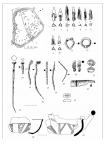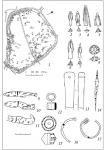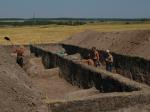Summary (English)
Ash hill 13.
It had been explored since 2005 and this year excavating trenches measured 144 m2 were dug out on the northern sector of the mound where four household pits and an altar with the remnants of the sacrificial animals were explored.
The altar was constructed in a form of a circle 0.8 m in diameter using burned clay. Additionally, its surface was covered with a thin layer of white clay. Fragments of another broken altar were found dumped at the bottom of pit 8.
An interesting object is a pit 10 3.4 m deep. Numerous fragments of the Greek amphorae and storage jars were deposited in it at the level 1.6 m deep. Besides that, a horn tip of the bow ornamented in the Scythian animal style was laid at the bottom of the pit. Interesting, that the images were not finished and the tip had no traces of usage.
Apart from the mentioned complexes, a big anomaly that was detected during the previous geophysics surveys was partly examined by the archaeologists. It has appeared that it is a big object (dwelling 4) covered with a dumped burned clay. Interesting clay lamp with three legs could be mentioned among the other finds, such as handmade pots and luxurious black-glazes table wares. But the most fascinating finds are the dogs’ skeletons discovered in this object at the level 2.4-2.65 m. One of the killed dogs had a necklace made of miniature beads that lay around its cervical vertebrae. A cowrie shell was found near the skull of the other dog.
Besides the local products, a lot of fragments of the Greek amphorae was found on the ash hill 13. Also, a single fragment of the painted oenochoe dated by the late 7th – early 6th c. BC could be mentioned.
Ash hill 10.
An excavating trench measured 237 m2 was dug out at the western part of the ash hill. A big pit-house measured 7 × 4.5 m was discovered at the southern part of the excavation site. It was filled with ashy soil mixed with layers of charcoal and ash as well as a lot of pottery fragments were deposited within. Besides the pit house, five household pits were explored here. Some of the table wares from the objects were ornamented with a carved geometric ornament filled with white paste. Fragments of the Greek amphorae oenochoe are dated by the late 7th – early 6th c. BC. The most interesting imported find is the Olbian coin in form of a dolphin.
- Shelekhan Oleksandr - Institute of Archaeology, National Academy of Sciences of Ukraine
Director
- Iryna Shramko - V.N. Karazin Kharkiv National University
- Stanislav Zadnikov - V.N. Karazin Kharkiv National University
Team
- Vladislav Bondarenko - V.N. Karazin Kharkiv National University, Museum of Archeology and Ethnography of Slobidska Ukraine
- Kseniia Bondar - Taras Shevchenko National University of Kyiv
Research Body
- ДП «Слобідська археологічна служба» ОАСУ Інституту археології НАН України / State enterprise «Slobidska archeological service» of the state enterprise «Protection of the archeological survey of Ukraine» of the Institute of Archeology of the National Academy of Sciences of Ukraine






![Download [PDF]](/excavation/skins/fasti/images/results/download_sml.png)

